
Exhibition entfaltet
The exhibition entfaltet deals with questions about reinterpretation and notation as strategies to preserve and mediate timebased media art.
What does this mean in the museum context, in matters pertaining to preservation? And in the case of reinterpretation when do we speak of a new work? Which information a score should contain and how should this information be displayed?
These and other questions were discussed and analysed at the symposium entfalten in December 2017.
The artworks, commissioned by IMA Institute of Media Archeology, shown in the exhibition entfalten – Axel Stockburgers reinterpretation Read my Lips of Gerda Lampalzers Translation from 2003 and Seppo Gründlers reinterpretation Whiteout of Richard Kriesches Blackout from 1974, as well as the score of the interactive sculpture You Never Know by Hillevi Munthe and Elisabeth Schimana, generated in a four day worklab by the artists in collaboration with the preservation expert Claudia Röck – are possible answers to these questions. In opposite the exhibition shows documentations of the reenterpretated works Translation and Blackout, as well as the sculpture You Never Know.
Program
Read my lips (2018) | Axel Stockburger more
READ MY LIPS
Gerda Lampalzer’s video installation Translation from 2003, was based on the idea that every human language could potentially contain the others on the level of spoken sound. Following this idea, conversations with four non german speakers were poetically “translated” into german with a new meaning, through the use of video editing software.
4 HD Videos, 30:00 min
The reinterpretation of Gerda Lampalzers Translation, transfers this conception towards the level of the image. The video of a speaker of a text in one language, becomes the starting point for a poetic translation by lip readers, who were socialised in other languages. The basic material for this translation is a spoken list of artificial languages, ranging from Esperanto and Volapük towards fictional languages from Literatura and media, such as Klingon or the languages from Tolkien’s Lord of the Rings.
The aim of Read My Lips is to experiment with the potential of meaning that results from the visual material of different positions of the speaker’s mouth. In this sense, the matrix of poetic transformation, which is at work in Gerda Lampalzers work of art, which operated on the level of spoken language and showed its operational traces in the edited video, is shifted towards an exploration of the potential of the image. Contemporary phenomena, such as the youtube sensation of “bad lip reading” as well as the recent surge in artificial intelligence technology connected to lip reading, form the background for this experimental setting.
Concept, Camera, Sound, Post-production: Axel Stockburger / Translation: Lippenleser-Agentur Judith und André Harter, www.lippenleser.de / Actor: Brishty Alam / Speakers: Anna Ceeh, Marlene Maier, Emilia Lopez.
Produced with funds by the IMA Institute for Media Archeology. Thanks to: Gerda Lampalzer, Elisabeth Schimana, Dariusz Kowalski, Kai Maier-Rothe.
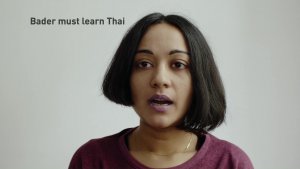
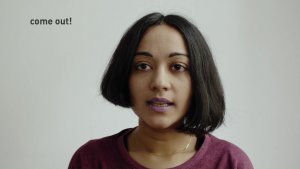
Reinterpretation von Gerda Lampalzer | Translation (2003) more
TRANSLATION
The main inspiration for the TRANSLATION project was the idea that in every language another language could be hidden. To hear wrongly or rather to hear newly has been the starting point for the TRANSLATION project, in which four persons were filmed with a video camera while speaking in their native tongues (Russian, Japanese, Spanish, English). These statements were cut up into the smallest sound particles and then edited into a German text. This method of creation is something like a free imitation. I imitate a programme for artificial text production. The method is also quite crude (the smallest possible video unit is a twenty-fifth of a second). What I expect the new text to be is intelligible, at least in parts. By rigging up one language from another (and rigging is a good description for this reconstruction of phonetic structures) the meaning of the language is also totally reconstructed. The new texts are not the result of a conventional translation, their semantic contents have changed completely.
With: Sergey Panteleev, Rie Takahashi, Jorge Daniel Valencia, Kim Hogben.

Whiteout (2018) | Seppo Gründler more
WHITEOUT – how near we are able to come to reality 2018
Reinterpretaion of blackout – how closely does television affect me by Richard Kriesche (1974/75)
How acts the communication medium, in particular in the current form of VR glasses, which are available in the meantime at any Italian motorway service area, on reality and our communication. The audience has to use VR goggles and headphones, so it seems to enter the same space like in Richard Kriesche’s blackout and is in an identical state of reality. This time even more congruent, yet more diverse than it could possibly be. In passivity and immobility, white noise is acoustically and visually projected.
In terms of signal theory, this represents the simplest stochastic process. Exposed to this for a few minutes, each individual experiences the Ganzfeld effect, hallucinations produced by perceptual deprivation. Through movement, different frequency bands, tones and patterns can be extracted from the noise, very elementary forms and sounds. Thus, the audience is free to generate by passivity complex hallucinations or activly seeming to generate rudimentary forms.
In the current Installation one can experience two versions. An interactive VR program for the Oculus RIFT SDK1, in which white noise as image and sound can be modulated by head movements, and a Google cardboard prototype, which uses the cardboard as glasses/projection screen to modulate a whiteout with noise. The Ganzfeld effect should occur after concentrating for a while on the noise center.As Günther Anders writes in The Antiquity of Man, those who are put to death can choose whether they want their last meal sweet or sour.
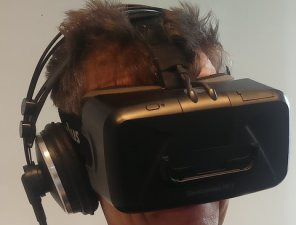
Reinterpretation von Richard Kriesche | Blackout (1974) more
BLACKOUT – how closely does television affect me 1974/75
in this media live action the artist asked himself and all those involved the question: how closely does television affect me? what does the communication medium of television make of reality? – what reality does “television” develop from “non-vision”?
during the recording of the programme the artist wore a black blindfold. The non-vision excluded the artist – he spoke into a space that was imaginary for him. at the same time, however, it was also his intention to confront the television audience with his situation of “no longer seeing”. to see nothing other than a black screen on the air on television. on this electronic media level – according to kriesche – the recipient and producer, artist and public would find themselves in the same state of reality. on the black screen the producer’s reality would be transformed into the recipients’ reality. due to the elimination of the distance from the visual image, the visible retreated into electronic space [note: this was not achieved, since the cameraman did not or could not comply with the artist’s instructions to come up so close to him that only the black blindfold would be visible.]
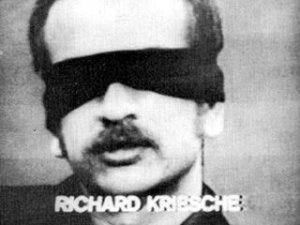
You Never Know notiert (2017) | Elisabeth Schimana / Hillevi Munthe / Claudia Röck more
YOU NEVER KNOW NOTATET
During a four-day artistic retreat Elisabeth Schimana and Hillevi Munthe will collaborate with with Claudia Röck, a conservator who specializes in software-based art, to develop a form of notation for the interactive sculpture You Never Know. Hard- and software will be examined closely and processes analyzed and transferred into a metalanguage intended to continue to endure 10,000 years from now. elise.at
»As I said, the fact, that you took the initiative to write a score for your artwork in contrast to a conservator documenting an artwork in a museum, gives the score/documentation a different significance.
You did a lot of research and trial and error for your artwork. I think, it is part of the artwork. Would you like somebody else to continue that research and within which scope? How much additional creativity would be allowed? For instance, I am assuming, that the metal frame and the textile should be preserved and only the electronic parts be replaced, if broken. I am also assuming, that the Arduinos could be replaced by DIY electronic boards of a different brand (but not a desktop or laptop computer). The music and muscle wire score you described on the righthandside of the poster has to be followed and cannot be changed. I am further assuming that the technology of the muscle wires is a significant property of your artwork and must not be replaced by a different technology. Although a lot of testing went into the power supplies, they are not a significant property of the artwork.
Another, more practical question is, whether – if an institution or a private person bought your artwork – they would be able to continue that research process in order to “preserve” or perpetuate your artwork (most museums would have difficulties, I presume, as they have different insititutional goals and as many of them are lacking the knowledge/skills).«
Claudia Röck, 25. Dezember 2017
You Never Know (2012-2015) | Hillevi Munthe / Elisabeth Schimana more
YOU NEVER KNOW
The sculpture is a tactile, intimate sound space designed to accommodate one person. It invites the visitor to enter and touch it. It reacts.
The idea behind You Never Know and its form come from thinking about movement. All parts are flexible: the semi-stable metal frame, the moving textile skin that applies shape memory alloy technology (muscle wire), or the sound flowing over the object. Embroidered potentiometers and sewn touch sensors allow the visitors to interact with the objects.
Intimate spaces are flexible spaces, unforeseeable. So, you never know…
Conception: Hillevi Munthe & Elisabeth Schimana Textile Haut, Muscle Wire | sensors: Hillevi Munthe | Sound and interaction: Elisabeth Schimana | Metal work: Eskil Tin | Technical work: Norbert Math und Günther Schiebeck | Production Assistance: Lea Basch
Coproduced by Atelier Nord, Oslo, and IMA Institute for Mediaarcheology, Hainburg
elise.at
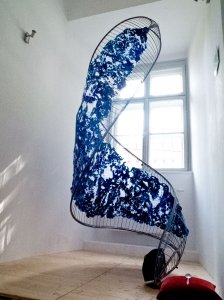
- Date: 12 01 2018 - 29 01 2018
Place: Medienwerkstatt Wien
Opening: 12 01 2018 19:00
Exhibition: Fri | Sat | Mon 14:00 - 18:00
With
Curator:
Gerda Lampalzer
(AT)
/
Elisabeth Schimana
(AT)
Artists:
Axel Stockburger
(AT)
/
Seppo Gründler
(AT)
/
Elisabeth Schimana
(AT)
/
Hillevi Munthe
(NO)
/
Claudia Roeck
(CH)












